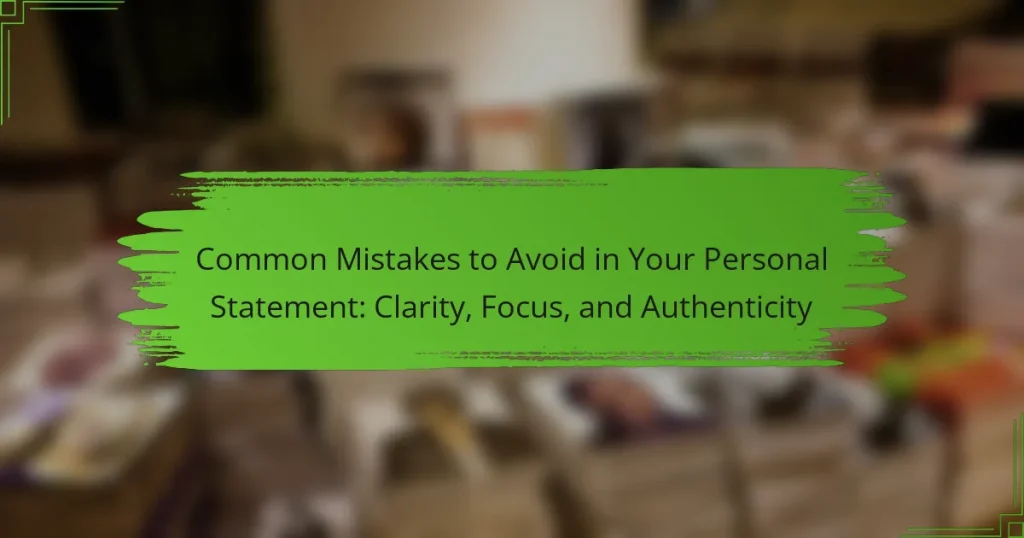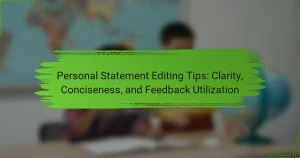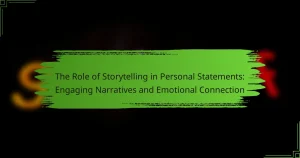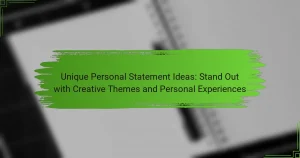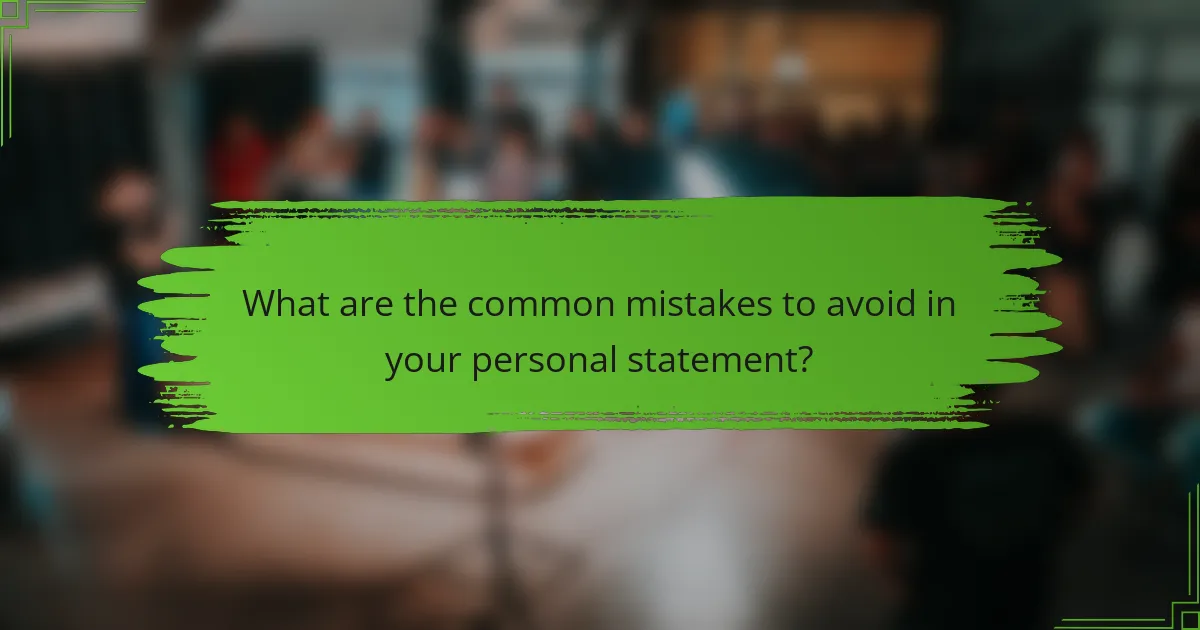
What are the common mistakes to avoid in your personal statement?
Common mistakes to avoid in your personal statement include vague language, lack of focus, and excessive jargon. Vague language makes it difficult for readers to understand your key points. Lack of focus can lead to a disjointed narrative that fails to highlight your strengths. Excessive jargon can alienate readers who may not be familiar with specific terms. Additionally, failing to personalize your statement can result in a generic impression. Overly lengthy statements may dilute your main message. Not proofreading can lead to grammatical errors that undermine your credibility. Lastly, neglecting to showcase your unique experiences can make your statement less memorable.
Why is clarity important in a personal statement?
Clarity is important in a personal statement because it ensures the reader understands the applicant’s message. A clear personal statement effectively communicates goals and motivations. It allows the admissions committee to assess the applicant’s suitability for their program. Ambiguity can lead to misinterpretation of the applicant’s intentions. Clear language demonstrates the applicant’s ability to articulate thoughts. Studies show that concise statements are more persuasive. Clarity also reflects professionalism and attention to detail. Ultimately, clarity enhances the overall impact of the personal statement.
What elements contribute to clarity in writing?
Clarity in writing is achieved through several key elements. These include simplicity, coherence, and precision. Simplicity involves using straightforward language and avoiding jargon. Coherence ensures that ideas flow logically and are connected. Precision refers to the use of specific words that convey exact meanings. Additionally, proper structure enhances clarity by organizing content effectively. Consistent tone and style contribute to a reader’s understanding. Finally, thorough proofreading eliminates errors that can obscure meaning. Each of these elements plays a crucial role in making writing clear and comprehensible.
How can unclear language undermine your message?
Unclear language can significantly undermine your message by creating confusion. When your audience cannot grasp your intent, they may misinterpret your ideas. This misinterpretation can lead to misunderstandings about your qualifications or goals. Research shows that clarity in communication enhances comprehension and retention. A study by the National Center for Biotechnology Information found that clear language improves reader engagement and reduces cognitive load. Therefore, using ambiguous terms or convoluted phrases can alienate your audience. It is essential to express your thoughts clearly to convey your true message effectively.
How does focus enhance the effectiveness of a personal statement?
Focus enhances the effectiveness of a personal statement by ensuring clarity and coherence. A focused statement presents a clear narrative that aligns with the applicant’s goals. This clarity helps admissions committees easily understand the applicant’s motivations and qualifications. A personal statement lacking focus may confuse readers and dilute the message. Research indicates that concise and targeted writing increases engagement and retention. Specific examples of achievements or experiences that relate directly to the applicant’s goals reinforce this focus. Thus, maintaining a clear focus is essential for creating a compelling personal statement.
What are the risks of lacking focus in your narrative?
Lacking focus in your narrative can lead to confusion and disengagement from the audience. When a narrative lacks clarity, readers may struggle to understand the main message. This can result in losing their interest and attention. A disjointed narrative can obscure the key points you want to convey. It can also dilute the impact of your personal statement. Without focus, the narrative may appear unfocused and aimless. This can diminish the overall effectiveness of your communication. Studies show that clear and focused narratives are more persuasive and memorable.
How can you maintain focus throughout your statement?
To maintain focus throughout your statement, define a clear central theme. This theme should guide your narrative and ensure coherence. Each paragraph must relate back to this theme, reinforcing your main point. Avoid introducing unrelated ideas that can distract the reader. Use topic sentences to signal the main idea of each paragraph. This structure helps maintain clarity and focus. Additionally, review your statement to eliminate any content that strays from your central message. Consistency in tone and language also supports focus. By adhering to these strategies, your statement will remain clear and engaging.
Why is authenticity crucial in a personal statement?
Authenticity is crucial in a personal statement because it establishes trust and credibility. Admissions committees seek genuine reflections of an applicant’s character and experiences. Authentic statements resonate more with readers and create a memorable impression. They allow applicants to showcase their unique perspectives and motivations. A study by the National Association for College Admission Counseling found that authenticity significantly influences admission decisions. Genuine narratives help differentiate candidates in a competitive environment. Therefore, authenticity enhances the overall effectiveness of a personal statement.
What does it mean to be authentic in your writing?
Being authentic in your writing means expressing your true self and thoughts. Authentic writing reflects your unique voice and perspective. It involves honesty about your experiences and feelings. Authenticity builds trust with your audience. Readers connect more deeply with genuine narratives. Research shows that personal stories resonate more effectively. For example, a study by the University of California found that authenticity increases reader engagement. Therefore, authenticity is crucial for effective communication in writing.
How can inauthenticity affect the reader’s perception?
Inauthenticity can significantly distort the reader’s perception. It creates distrust and skepticism towards the content. Readers often sense when a personal statement lacks genuine emotion or experience. This perception can lead to negative evaluations of the writer’s character and intentions. A study by the University of California found that authentic narratives resonate more with readers. Authenticity fosters a connection, while inauthenticity alienates the audience. Consequently, inauthentic personal statements may fail to engage or persuade effectively.
What are the consequences of common mistakes in personal statements?
Common mistakes in personal statements can lead to negative outcomes. These mistakes may result in rejection from academic programs or job opportunities. Errors such as poor grammar and spelling reflect a lack of attention to detail. Lack of clarity can confuse the reader and dilute the applicant’s message. Failing to demonstrate authenticity may lead to perceptions of insincerity. A personal statement that lacks focus can appear unfocused and unconvincing. Consequently, applicants may miss the chance to showcase their strengths and experiences effectively. Overall, these mistakes can significantly diminish an applicant’s chances of success.
How can you identify mistakes before submission?
To identify mistakes before submission, thoroughly review your document. Read your personal statement multiple times. Each reading should focus on different aspects, such as grammar, clarity, and coherence. Utilize tools like grammar checkers for initial error detection. Seek feedback from peers or mentors for diverse perspectives. Compare your statement against guidelines provided by the institution. This ensures adherence to requirements. Lastly, take breaks between edits to gain fresh insights. These practices enhance the quality of your submission.

What strategies can help improve clarity, focus, and authenticity?
To improve clarity, focus, and authenticity in a personal statement, use clear and concise language. Avoid jargon and complex sentences. Focus on a central theme to maintain coherence. Use personal anecdotes to enhance authenticity. Ensure each paragraph supports the main message. Edit rigorously to eliminate unnecessary words. Seek feedback from peers or mentors for perspective. Research shows that concise writing improves reader engagement and comprehension.
What techniques can enhance clarity in your writing?
Use simple language to enhance clarity in writing. Avoid jargon and complex vocabulary. Short sentences improve readability. Each sentence should express one idea. Active voice makes sentences stronger. Organize thoughts logically with clear structure. Use headings and bullet points for easy navigation. Edit ruthlessly to remove unnecessary words. These techniques improve understanding and engagement.
How can you simplify complex ideas for better understanding?
To simplify complex ideas for better understanding, break them into smaller parts. Use clear and concise language. Avoid jargon and technical terms. Use analogies to relate unfamiliar concepts to familiar ones. Visual aids can enhance comprehension. Organize information logically, presenting one idea at a time. Encourage questions to clarify understanding. Reiterate key points to reinforce learning. Research shows that chunking information improves retention (Miller, 1956).
What role does proofreading play in achieving clarity?
Proofreading ensures clarity by identifying and correcting errors in writing. It helps eliminate grammatical mistakes, spelling errors, and punctuation issues. These errors can obscure the intended message. A clear message is essential for effective communication. Research shows that clarity in writing enhances reader comprehension. For instance, a study by the National Center for Biotechnology Information found that clarity improves retention of information. Proofreading also allows writers to refine their ideas and structure. This refinement leads to a more coherent flow of thoughts. Overall, proofreading is crucial for achieving clarity in personal statements.
How can you ensure your personal statement remains focused?
To ensure your personal statement remains focused, clearly define your main message. This message should reflect your goals and motivations. Each paragraph must support this central theme. Avoid including unrelated experiences or excessive details. Use specific examples to illustrate your points. This approach maintains clarity and keeps the reader engaged. Regularly review your statement to check for alignment with your main message. This practice helps eliminate distractions and strengthens your narrative.
What tools can help you outline your main points?
Mind mapping software can help you outline your main points. Tools like MindMeister and XMind allow visual representation of ideas. These tools enable users to create structured diagrams. Users can easily rearrange points for clarity. Outlining becomes more intuitive with visual aids. Additionally, word processors like Microsoft Word offer outlining features. These features allow users to create hierarchical lists. This structure helps maintain focus on main ideas. Using these tools enhances organization and clarity in writing.
How can feedback from others improve your focus?
Feedback from others can enhance your focus by providing external perspectives on your work. This input helps identify areas that may need more clarity or emphasis. Constructive criticism often highlights blind spots that you might overlook. When others point out distractions in your writing, it allows you to refine your message. Research shows that peer feedback can lead to improved writing quality and coherence. A study by Cho and Schunn (2007) found that students who received feedback demonstrated better focus in their revisions. This indicates that external insights can effectively guide your attention to critical aspects of your personal statement.
What practices foster authenticity in your personal statement?
Being genuine and self-reflective fosters authenticity in your personal statement. Use your unique voice and experiences to convey your story. Share specific anecdotes that illustrate your values and motivations. Avoid clichés and generic statements that lack personal significance. Reflect on challenges you have faced and how they shaped you. Be honest about your aspirations and goals. Seek feedback from trusted individuals to ensure your voice remains intact. Authenticity resonates with readers and makes your statement memorable.
How can personal stories enhance authenticity?
Personal stories enhance authenticity by providing a unique, relatable perspective. They allow individuals to share their experiences, emotions, and lessons learned. This personal connection fosters trust with the audience. Authenticity is often perceived when storytelling reflects genuine thoughts and feelings. Research shows that narratives create emotional engagement, making the message more impactful. For instance, a study by the University of Pennsylvania found that personal anecdotes significantly improve listener retention. Thus, incorporating personal stories in statements can strengthen the overall authenticity of the narrative.
What should you avoid to maintain authenticity?
To maintain authenticity, you should avoid exaggeration and insincerity. Exaggeration can lead to a misrepresentation of your true self. This can make your personal statement feel less genuine. Insincerity often arises from trying to please others instead of expressing your true thoughts. Authenticity requires honesty about your experiences and feelings. Using clichés can also detract from your unique voice. Relying on common phrases can make your statement blend in rather than stand out. It’s essential to present your real self to connect with your audience effectively.

What are the best practices for crafting a compelling personal statement?
To craft a compelling personal statement, start with a clear and engaging introduction. This introduction should capture the reader’s attention immediately. Next, outline your motivations and goals in a concise manner. Use specific examples to illustrate your experiences and achievements. Ensure that your narrative reflects your authentic voice and personality. Tailor your statement to the specific program or opportunity you are applying for. Maintain a logical flow of ideas throughout the statement. Finally, proofread for grammar and clarity to eliminate errors. These practices enhance the overall impact of your personal statement.
How can you create a strong opening for your statement?
To create a strong opening for your statement, start with a compelling hook. A hook can be an intriguing question or a powerful quote. This immediately engages the reader’s interest. Next, provide context that relates to your main theme. This sets the stage for your narrative. Clearly state your purpose or main argument in the opening. This gives direction to your statement. According to experts, a strong opening can significantly impact the reader’s perception. Research shows that first impressions are formed within seconds. Therefore, investing time in crafting an effective opening is crucial for success.
What closing strategies leave a lasting impression?
Effective closing strategies that leave a lasting impression include summarizing key points, expressing gratitude, and providing a call to action. Summarizing reinforces the main message and ensures clarity. Expressing gratitude shows appreciation for the reader’s time and consideration. A call to action encourages engagement, prompting the reader to reflect or take the next step. Research indicates that personal statements that conclude with these elements are more memorable and impactful. For instance, a study by the University of California found that applicants who effectively summarized their experiences and expressed appreciation received higher evaluations.
What final tips can ensure your personal statement is error-free?
To ensure your personal statement is error-free, conduct thorough proofreading. Read your statement aloud to catch awkward phrasing. Utilize grammar checking tools like Grammarly for additional support. Have a trusted friend or mentor review your statement for clarity and coherence. Check for consistent formatting, including font size and spacing. Ensure all names, dates, and titles are accurate and correctly spelled. Lastly, take breaks between revisions to approach the text with fresh eyes. These steps significantly reduce the likelihood of errors.
The main entity of the article is “personal statement,” with a focus on common mistakes to avoid that impact clarity, focus, and authenticity. Key points include the importance of clear language to convey messages effectively, maintaining a focused narrative to engage readers, and showcasing authentic experiences to build trust with the admissions committee. The article outlines specific mistakes such as vague language, lack of coherence, excessive jargon, and the need for thorough proofreading to enhance the overall effectiveness of personal statements. Strategies for improvement, including the use of personal anecdotes and feedback from peers, are also discussed to help applicants create compelling and memorable statements.
